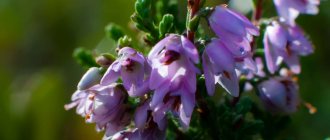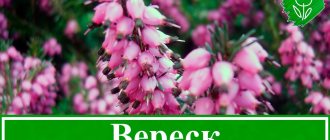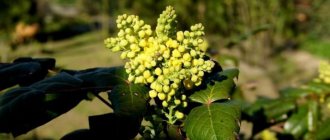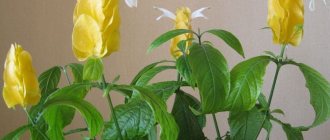The herbaceous evergreen plant common heather (Calluna vulgaris) is the only species of the heather genus belonging to the Ericaceae family. Today there are approximately 500 varieties of this plant, most of which have very high decorative qualities. Under natural conditions, the plant is found in Europe (distributed from the coniferous-deciduous fox zone to the tundra), in North Africa, in Greenland, in the temperate latitudes of Asia, in the Azores Islands, on the Atlantic coast of North America, while it prefers to grow in peat bogs, burnt areas and forests. An old Scottish legend says that of all the plants, only heather agreed, at the request of the Creator, to grow on the rocky bare hills, which are blown by all the winds, for this he was awarded unpretentiousness, endurance, good aroma and charming appearance. And today, in those places where heather grows, there is no other plant. Sometimes it occupies huge areas, which are called heather heaths. Heather gave the name to September in the Belarusian, Ukrainian and Polish languages, namely: veresen, verasen, wrzesien.
Description
Only one species belongs to the genus Heather - Common Heather.
But the number of very decorative varieties reaches 300 and continues to increase thanks to the efforts of breeders, which indicates the great popularity of this amazing plant. Heather is often confused with the charming representative of the numerous Heather genus (Ericaceae) - Erica, but despite all the external similarities they have noticeable differences.
This shrub has always been a legendary plant in the cultures of many countries. In Norway it is the national flower.
According to Scottish legend, when God distributed plants throughout the earth, only Heather agreed to live on their poor, windswept soil. For which he was awarded special endurance, exquisite beauty and amazing durability.
An evergreen, fast-growing shrub that can be creeping or highly branched. It has very decorative foliage in various shades of green (from light green to silver gray). Some varieties have foliage that is red, orange, bronze, or gold. The leaves are small, whorled, narrow, oblong (0.5-2 cm), triangular, sometimes pubescent. They give the shrub a special modest charm. But when the Heather blooms, it becomes a bright star and a decoration of the house or garden for a long time.
Small, barrel-shaped bells are formed by four to five simple or partially fused petals of incredible colors. Even Heathers with double and super-double flowers have been bred, as if strewn with small fragrant roses. They almost completely cover the bush, turning it into a blooming outbreak. Small flowers are collected in lush pyramidal or round paniculate inflorescences.
The flavonoids, arbutin, and resins contained in the plant make it indispensable in medicine in the treatment of a huge number of diseases. The leaves are also used to make dye for the fabrics of the famous Scottish kilts and rugs.
Heather has a delicate aroma and is an excellent honey plant.
Features of heather
Heather is a strongly branching evergreen creeping small shrub 30–70 centimeters high. Small leaf plates, which are triangular, seem to be rolled into a tube. Small fragrant flowers, similar in appearance to bells, are colored lilac-pink. They are part of one-sided brushes. Flowering begins in the second half of summer, but this plant becomes most beautiful after the first frost, because at this time its leaves turn burgundy and yellow. Robert Louis Stevenson wrote an entire ballad about heather, “Briar Honey.” This plant is an excellent honey plant, and heather honey is considered the most useful of all. Landscape designers use heather to decorate alpine hills, plant it along paths in the garden, and use it to create borders that look very impressive against the backdrop of dwarf coniferous plants.
Heather
Growing
In nature and gardens, Heather blooms from June to August, but at home, flowering may shift to October-March. Withered flowers dry out without losing color, and remain on the plant for several months, maintaining its high decorative value. Therefore, they can not be cut for a couple of months. But if dried flowers are removed, other branches will grow and bloom more abundantly.
Heather is an unpretentious plant. There are some features of its cultivation that need to be taken into account, then it will delight you with its flowering for many years. After all, Heather lives up to 30 years.
In a temperate climate, for the summer the bushes can be moved to the balcony, even to a sunny place, not forgetting about frequent watering and spraying.
For more luxuriant branching and flowering, branches are pinched. After flowering ends, the bush is subjected to formative pruning.
Reproduction is possible in a greenhouse or greenhouse. Seeds and cuttings take root well, but flowering occurs in 3–5 years. Therefore, it is easier to purchase an already mature plant at the beginning of flowering.
Useful properties of heather
Heather has medicinal properties that are used in both folk and traditional medicine. It is widely used in the treatment of cough, kidney disease, cystitis, pyelitis, urethritis, dysentery, diarrhea, gastritis, enterocolitis, rheumatism, gout, and also skin diseases. Flowering heather is harvested from the last days of June to September, because during this period it contains the largest amount of useful substances: flavonoids, mineral salts of phosphorus, potassium, calcium and sodium, organic acids. Thanks to them, the plant has antibacterial, anti-inflammatory, diaphoretic, wound-healing, expectorant, diuretic, astringent, cleansing and sedative effects.
A decoction of this shrub is used for insomnia and disorders of the nervous system, atherosclerosis of blood vessels, diseases of the gastrointestinal tract, hyperacidity, cholecystitis and obesity. If the throat is sore or there is inflammation in the mouth, then the decoction is used for rinsing. An alcohol tincture of this plant helps with tuberculosis. Crushed flowers are used to make a powder that helps with ulcers, eczema, wounds and burns. For radiculitis, take heather baths. An infusion made from flowers is rubbed into the scalp, this helps get rid of hair loss and make it healthier.
Anyone can take heather, but before starting treatment with this plant, you should consult with an experienced doctor. It is better to refrain from ingesting medicines made from heather for those who have low acidity of gastric juice.
Why do heathers dry out? Website "Garden World"
First steps after purchase
When purchasing such a beautiful plant as Heather, you should pay attention to the condition of the branches and flowers. The fact is that a bush can die from even short-term drying out of the soil during transportation. This will not affect the appearance at all. It does not lose its decorative effect for months and stands perfectly as a dried flower. But I still want to get this treasure alive. Therefore, you need to check the condition of the plant before purchasing it. The branches should be flexible, alive, and the flowers should not fall off.
Having brought Heather into the house, it is worth giving it a short cool shower, which will wash away possible pests (especially spider mites) and have a beneficial effect on the plant. Immediately place the pot with the plant on a tray with wet peat or pebbles.
Heather after flowering
In regions with warm climates, this plant tolerates winter well without shelter. But if the winters are harsh and there is little snow, it is better to prepare the heather for wintering. When frost sets in, the surface of the area must be sprinkled with a layer of peat, and then the heather itself must be covered with spruce branches, which will protect the plants from frost and from sunburn in the spring. The shelter will need to be removed in April.
Secrets of success
For Heather, acidic (pH 4.5–5.5) not very nutritious, but loose soil is suitable, which should be constantly moist, but without soaking. It is very important to have good drainage, otherwise the plant may quickly die.
The plant should be watered and sprayed frequently with well-settled soft water at room temperature. During the dormant period, watering is reduced and fertilizing is not done at all.
During the growing season and flowering, the plant responds well to fertilizing with organic fertilizers once a month. At the beginning of spring you need to replant it and feed it once with full mineral fertilizer.
Very interesting is the symbiosis of Heather with some types of soil fungi, which help it absorb nutrients and enrich the soil. The result is heather soil, which can later be used for planting Hydrangeas, Azaleas and plants that prefer acidic soils.
Heather loves cool rooms, fresh air and lots of sunlight. Keeping it at low temperatures of +7–12°C in winter and up to +20–24°C in summer will not allow Heather to die. It does not tolerate even short-term overdrying of the soil and hot, dry air. Frequent spraying will do him good.
Heather in landscape design
Until relatively recently, heather was not perceived by gardeners as a plant worthy of a place in a decent flower garden. Of course, heathers were associated with wild, uncultivated fields. But with the emergence of fashion for alpine hills and rocky gardens, this modest shrub managed to get a pass to the “civilized society” of cultivated plants.
A flowerbed consisting entirely of heather can indeed look somewhat boring and monotonous. Therefore, it is advisable to dilute it with herbs and shrubs, which also love acidic soil. These can be the same close relatives of heather (Erica and Dabecia), ornamental grasses (for example, miscanthus), rhododendrons, hydrangeas, junipers, thujas and other conifers.
We offer you several ideas for mixed borders with heather that you can repeat in your garden.
Spring mixborder: heather, Erica, anemone
This mixborder will delight you for a long time. Ericas (1) and anemonastrums (3) bloom in the spring, and in the summer the baton is picked up by heather (2), which remains in bloom until the beginning of autumn.
To ensure that the flower garden maintains a delicate pink and white color scheme until the end of the season, when the anemones have faded, plant several varieties of heather of different colors.
Autumn mixborder: heather, white dogwood, grass
This beautiful flower garden will delight you until late autumn. In this composition, heather (5) is juxtaposed with autumn-blooming white (2) and pink (3) Erica, white Siberica derain (1), Hakonechloa (6) and miscanthus (4).
This mixborder will look especially impressive in the morning, silvered with frost after night frosts.
- Idea for a delightful autumn mixborder
Scheme of a beautiful autumn flower garden in purple and yellow tones.
Evergreen mixborder: thuja, juniper, heather
This composition will look attractive all year round - all the plants collected here are evergreen and will decorate the garden even in winter.
Try planting heathers of different colors (2) and low-growing juniper (1) in the trunk circles of the thuja (3).
- 6 landscape design ideas with dwarf juniper
Win-win options for using low-growing juniper in the garden.
Blooming mixborder: hydrangea, rhododendron, heather
Fortunately, luxurious shrubs such as hydrangea and rhododendron, as well as heather, grow in acidic soils. Try to create a delightful flower garden in white, pink and blue tones: plant multi-colored heathers in the foreground (2), then several hydrangea bushes (1) and rhododendrons in the background (3).
The composition will look more interesting if you plant hydrangea bushes of different types and varieties nearby. A list of the most beautiful and unpretentious shrubs of this genus can be found in our review of the best hydrangea varieties for the middle zone.
Do you grow heathers on your property? Share with us your life hacks on the care and propagation of heather, as well as its use in landscape design.
Selecting a location and seedlings for planting
The heather plant loves bright, open spaces and light, barely noticeable partial shade. You need to choose a place for it carefully, because it does not like transplants and does not take root well in a new area.
It should be taken into account that heather does not like strong winds. Therefore, it should be planted in a free area, sheltered by a house wall or fence from the prevailing winds in the area.
Moist peat soil is suitable. Some varieties also do well in dry sandy soil. Calcareous soil is strictly contraindicated. After all, its acidity is essential for heather, pH is above five.
Artificial conditions can also be created for this plant by forming a soil mixture of peat and sand and coniferous tree bark compost. In this case, it is better to add sour red peat to the mixture, rather than dark, grassy peat.
Heather planting time is spring or autumn. Late April-early May or late September-early October.
Heather variety Peter Sparks
The variety was also bred by English breeders. In general, this group is easy to recognize not only by the color of the foliage, but also by the country in which most of its varieties were bred. The height of the bush reaches half a meter, the diameter of the oval-shaped crown is approximately 60 centimeters, no more. The bark is a dark brown color, the leaves are very small, more like scales.
In summer and autumn, it is green in color, but in winter and spring, the leaves are painted grayish-silver. You can also see light green shades, but again, this is only a feature of the variety and should be kept in mind. When they bloom, the flowers are pink, slightly terry, and form part of attractive inflorescences, whose diameter is no more than three centimeters. The variety is characterized by moderate frost resistance. However, sometimes it should be covered for the winter. Otherwise, the plant cannot always calmly react to too severe frosts.
Heather variety Autumn glow
A bush whose height is no more than thirty centimeters. The crown is usually about 45 centimeters in diameter and looks very good, especially if it is trimmed periodically. The ends of the branches are slightly raised, with dark, juicy green leaves on them. But the flowers are pale, but thick and double.
The inflorescences are shaped like brushes, quite dense, but short. One way or another, taken together these signs look really great. And the plant itself is also quite attractive and decorative.
Let's summarize
- Calluna is the Latin name for heather. This decorative shrub is represented by 300 varieties with different shades of leaves and fragrant flowers.
- The plant can be grown in an apartment. It needs to be watered regularly, kept in moist air, and pinched in the spring.
- But of course, more often heather is planted in flower beds. The creeping plant quickly forms a colorful carpet. It is important that the soil under the crop is acidic.
And you will learn about the most popular varieties of calluna and why it does not always take root in the garden or balcony box from this video:
Latin name: Calluna
species "Heather"
| The soil |
|
| Size |
|
| Flowering time |
|
| Possible colors | |
| Illumination |
|
| Watering |
|
| Difficulty of care |
|
| Air humidity |
|
| Fertilizer frequency |
|
Read also: Is it possible to give dry peas to pigeons?
Common heather (Calluna vulgaris) plant description, care and diseases, watering and propagation
Ericaceae family Description
Common heather (Calluna. Vulgaris) is a low-growing (creeping or ascending), evergreen, dense, branched shrub, rarely growing above 30 cm. Its branches are covered with narrow evergreen small leaves, among which mauve-purple flowers resembling bells open at the end of summer. They are collected in paniculate multi-flowered inflorescences at the ends of the branches. The root system of heather is fine-fibrous and densely branched, with a long and widely branched main root.
The most important condition for the existence of plants of this family was their “cohabitation” (symbiosis) with fungi. Mushroom threads closely entwine heather roots, supplying them with nitrogen and other nutrients from the soil. Plants without mycorrhizae die, despite careful care.
Therefore, anyone who wants purchased varietal heather or wild heather brought from the forest to take root in their garden plot should take a walk into the forest and collect land among the thickets of its close relatives, such as blueberries or wild rosemary. If necessary, add three parts of peat and one part to two parts of the soil you brought...
Heather variety David Eason
The bush is spherical in shape, its height is about twenty centimeters, the crown in diameter is no more than 25 centimeters. The branches are ascending and grow in large numbers. The leaf blades are painted in a dark green shade and look very interesting and fresh. The flowers are dark, purple or pinkish, the racemes are short, the flowers are collected in them, but never fully open, which is the peculiarity of the variety of this group.
Heather variety Silver Knight
It was bred by English breeders, but due to the large number of very positive traits and characteristics, this variety soon became very popular in other countries. The height of the bush reaches approximately thirty centimeters. And its crown is very compact, shaped like a pillow - usually its diameter is about 45 centimeters, no more.
The bark turns out to be a dark, brown shade, but the leaf plates have an atypical silver color. You can also see slight pubescence on them, which also indicates the decorative nature of this plant. With the onset of winter, the leaves gradually turn purple and become almost a dark burgundy shade. The flowers are simple, have a pale lilac color and are collected in inflorescences. However, they usually do not represent any decorative value, which cannot be said about the deciduous part.
Ordinary, yet amazing heather
There are more than a hundred plants in the Heather genus, but there is only one species called heather - common heather, or, speaking in the language of science, calluna vulgaris.
Thanks to the fact that breeders have long taken up the plant, calluna can please you with three hundred varieties, distinguished by different colors and shades of leaves and flowers.
The advantages of this shrub:
- it is decorative throughout the year - even when the flowers fade, they dry out and do not fall off the branches, continuing to look beautiful all winter;
- in our latitudes, evergreen heather does not need shelter for the winter, and when light snow dusts a heather garden or flowerbed, it looks very beautiful;
- this creeping crop quickly overgrows an open yard.
leaves can be all shades of green and light green, silver, golden, bronze, orange and red. The leaf blades are narrow, often with a smooth surface, less often pubescent.
The stem grows up to 25 cm upward.
The flowers resemble small bells, consisting of 4-5 fused petals. Sometimes there are varieties with double and even super-double flowers, reminiscent of small roses. Either way, they smell very nice. There are always bees swarming over the heather; it is a good honey plant.
You can admire the flowering of the subshrub from June to August . But this is only if it grows in the garden. Indoor calluna can bloom from October to March .
By the way, not everyone knows, but in the old days brooms were made from this plant. Actually, that’s why it’s called calluna (“kallunein” from Greek - “to cleanse”).
The use of heather in landscape design
The plant can be “made friends” with other crops (for example, by arranging it in the form of a border), or you can rely only on calluna, forming a heather garden . In this case, the heather can grow on the ground in a continuous carpet, in which one variety passes into another, dividing into multi-colored sections.
Or calluna in a heather garden can be slightly “diluted” with other plants and stones, creating the illusion of a “wild” landscape.
Also, this crop fits beautifully into alpine hills and looks impressive in combination with tall plants, especially conifers or beautifully flowering shrubs.











